In 2009, Dani Abram, an animator and comics creator from the UK, began getting stomach pains. She changed her diet, but the pain got worse and so did the feeling that something was very wrong. At work, she became a perfectionist and in the bath she scratched her skin raw. Then one day she bolted from a grocery store, convinced she was about to make a scene. Soon Abrams saw her doctor, who recommended she begin keeping a diary. That diary would eventually lead her to create Worry Wart, a comic about living with generalized anxiety disorder.
Comics like Abram’s, along with personal zines, continue to be crucial forms for women to tell their stories about anxiety, depression, trauma, and anorexia. For creators, making and sharing zines and comics is an empowering way of processing painful experiences and building self-acceptance and creative mastery. For readers, these works are an empathetic link to others who are living, struggling, coping with and sometimes triumphing over mental health issues, and an important reminder that they are not alone.
“I go in with confusion, pain, raw emotion, and through the writing I make meaning out of it. Through the creative process, I get in touch with my power.”
Before making her comic, Abram was mortified by her anxiety. “I didn’t want to tell my friends or my boyfriend at the time, for fear they wouldn’t believe me or they would be highly embarrassed by me,” she told me in an email. “To be honest, I didn’t even want to tell myself.”
Today, mental illness is becoming less stigmatized, but many still hide their struggles for the very real fear of being labelled, discriminated against, or treated as second-class citizens. After publishing her comics, however, Abram received letters praising her gutsiness. Her confidence grew. Today, Worry Wart is one of the most viewed webcomics about anxiety, drawing a readership from around the world. In many of the zines that follow, women also express how making and sharing their work increases their confidence and sense of self.
Comic and zine making also allows its creators to transform harrowing personal experience into art, a process that is both creatively and personally empowering. Clementine Morrigan, a Toronto-based zine maker, describes their creative process as a kind of crucible.
“I go in with confusion, pain, raw emotion, and through the writing I make meaning out of it,” Morrigan explains. “Through the creative process, I get in touch with my power.”
Zine and comic making, reading, and sharing are also ways for women to form communities of mutual support on the basis of shared struggle. Zines, with their handmade traces of their authors’ lives, are intrinsically intimate; so too are the distribution channels, which privilege author to reader connections. Creators form networks with other creators, and readers, both on and offline, and develop solidarities. This process overturns the traditional division between authors and readers, who rarely interact on this personal a level.
“Sharing your story can be a profoundly humanizing experience.”
Sharing one’s story with others who have gone through similar experiences can also reduce feelings of isolation. Quinn Rivenburgh, a Chicago-based artist and art therapist, has seen this many times firsthand. “Sharing your story can be a profoundly humanizing experience,” they told me by email. “I’ve seen this happen in a group therapy setting, where female-identified people drew comics about their experiences of sexual violence — and to each comic shared, there was a resounding chorus of ‘me too’ from other group members.”
Lina Wu, author of the zine For Girls Who Cry Often, concurs. “Even if it seems too personal or embarrassing, I think that if you are writing something honest, people will understand. If you allow yourself to be vulnerable in it, people will identify with that.”
Abram continues to get letters from people who tell her that her comic made them feel less alone. “I sometimes feel like a secret warrior, part of a worldwide crew of anxiety fighters lifting each other up in small but significant ways,” she says.
At the same time, if disclosing one’s struggles feels too risky, the physical form of comics and zines can offer creators a degree of privacy and control. Creators can, and often do, write under a pen name; control the number of copies they produce; choose where the zine gets distributed; and, to an extent, to whom. In her classic book Girl Zines, the late Alison Piepmeier argued that the physical form might help protect makers from misogynistic comments that are more likely to be left on a blog than sent through snail mail. For those who don’t want the 24/7 exposure the internet entails, physical zines and comics offer a compromise between privacy and self-disclosure. As Jenna Worth aptly put it, “producing zines can offer an unexpected respite from the scrutiny on the internet, which can be as oppressive as it is liberating.”
Of course, many creators intentionally place their work online to find larger audiences. Today, zines can be bought on Amazon.com and Etsy while publications that started as zines, like Bust and Bitch, have followings in the five digits. Some DIY comics are also crossing over into mainstream publishing. Allie Brosh’s webcomic, Hyperbole and a Half, which detailed her experiences with depression, was published as a book by Simon and Schuster. Dani Abram recently published her comic in book form as well.
This round-up offers a very brief glimpse into the rich world of comics and zines about mental health issues. If you read just one, you will be led to many others. By writing and drawing out (literally and figuratively) difficult stories, these creators offer sincere and courageous disclosures, stories that are by-products of pain, and necessary reading. They use art to lay claim and own a reality that is often impossible to talk about in everyday life.
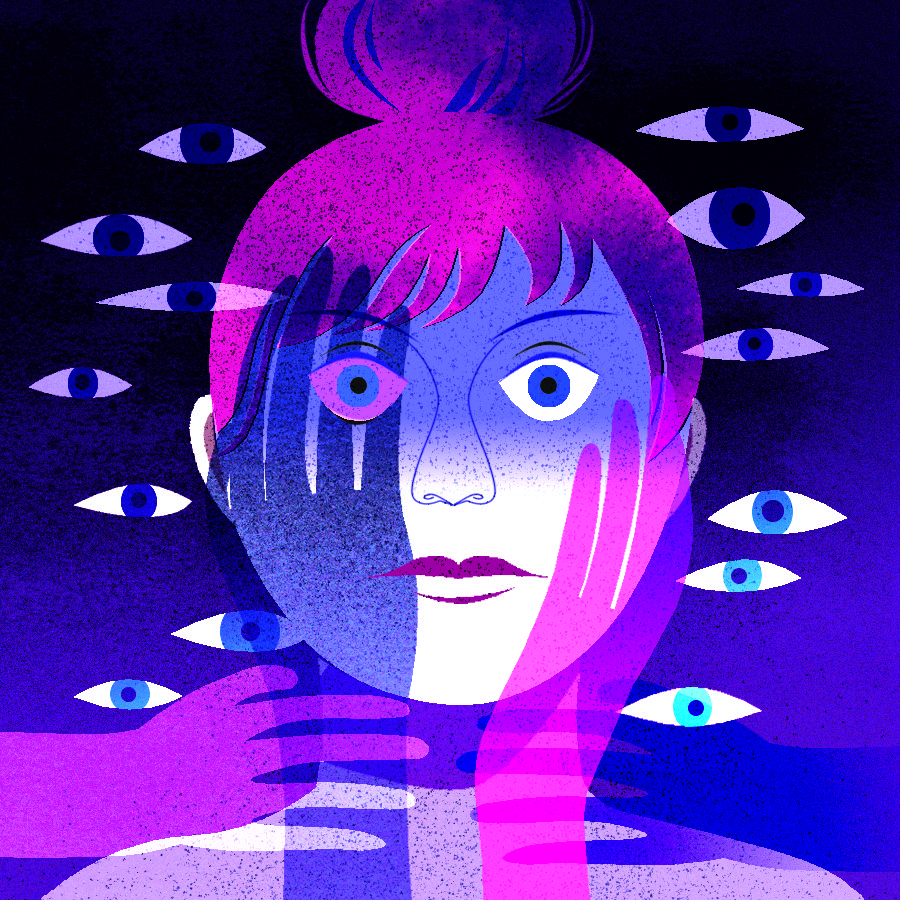 Illustrations by Jenn Liv
Illustrations by Jenn Liv
Depression

Hope and despair rivet the stories in Lina Wu’s lovely zine For Girls Who Cry Often (2015), which captures the melancholia of teenagehood’s bandaged heartsongs, juxtaposing writings on self-harm and suicidal thoughts against a pinky palette of photographs and drawings. Formally innovative, Wu constructed the narrative from survey answers she received from over a dozen teenage girls. The zine also offers a trove of coping skills.
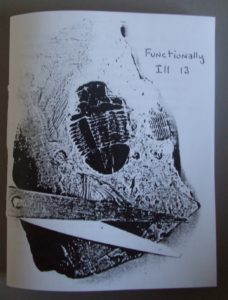
Functionally Ill, issue 13 (2013), by Laura-Marie, is a text-only zine filled with interviews she conducted with zinesters about their depression, bipolar disorder, narcolepsy and PTSD. Many spin mighty metaphors, like Jordan, who describes their depression feeling like “a house with lots of windows and most of them I can’t close, and the windows have no screens on them…” Laura-Marie met many of her interviewees through zines, making the issue itself a testament to the valuable connections zines can create.
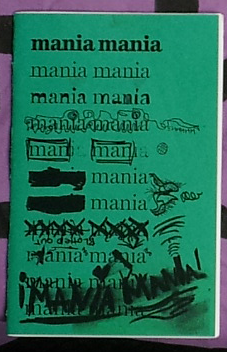
Sylvia’s Mania, Mania, Mania (2014), an intrepid log of manic depression, toes the line between humour and pathos. “I lost a lot of money, cried a lot of years, and my brain now looks like a wedge of Swiss cheese because I’m addicted to drugs.” Diagnosed at 15, she began making zines at the same time (during a manic phase) in the hope of connecting to other people.
Clark 8 (2003), by Megan Gendell, is an account of the author’s one week stay at a mental hospital while a student at Columbia University. Written in deadpan prose laced with crushing poetic lines (“the world turned completely to ocean; I was without landmarks, bewildered and drowning”), this zine is lucid and powerful. Gendell’s imaginary connection to the photographer Francesca Woodman, who died by suicide in 1982, is especially fascinating.
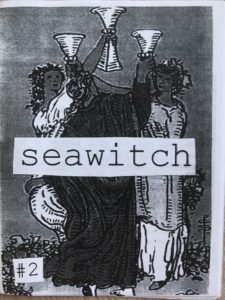
Clementine Morrigan’s evocative zine, Fucking Magic (2015 – ), which they describe as a “deep dive into childhood trauma and living with the legacy of surviving childhood sexual abuse,” follows ther previous zine, Seawitch, a tapestry-rich compendium of poetic and raw narratives about, among other things, survival and scars. Morrigan refreshingly avoids self-deprecation and luminously revels in the beauty of their developing teenage body, a rarity for young women, saying that they are “massively enamored with my body, my new breasts, my new armpit hair, my stretch marks, my expansive sexuality.” Both are powerful.
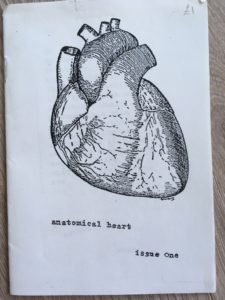
Anatomical Heart (2008), by Bettie, an intimate perzine, reflects on depression, hospitals, experts, and pills. Capturing the ambivalence of prescription drug therapy, she wonders if she might have “a whole other personality underneath” her medicated one. Particularly moving are the author’s difficulties accessing benefits, being stigmatized as a “scrounger,” and ultimately left in the lurch, feeling too sick to work, yet deemed fit enough by the government and denied disability benefits.
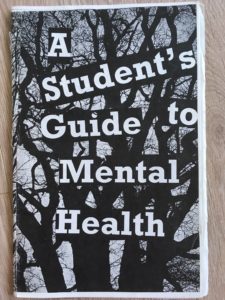
A Students Guide to Mental Health (2015) is jam-packed with personal narratives and constructive advice, opening with Amelia’s story about heredity and depression. “I had always prided myself on being the one person in the family who wasn’t depressed,” she writes. After her own diagnosis, she had to reconsider her own ideas about herself, a painful process she captures lucidly.
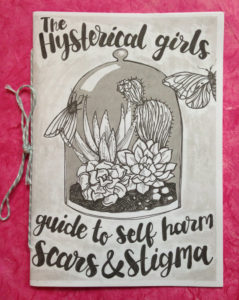
The Hysterical Girls Guide to Self-Harm (2015), by Polly Richards, with Jodie Matthews, is a spirited 15-page zine on, as the authors put it, “dealing with visible self-harm in society.” While the zine focuses on the practical (tips for healing and hiding scars), it also meditates on the motivations behind self-harm with personal and heartfelt reflections.
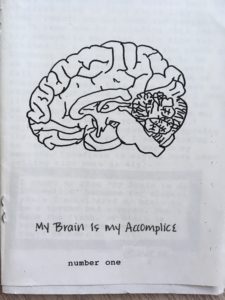
My Brain is My Accomplice (undated), by Cortney, is an affecting record of recovery using zine-making as a coping skill. “For sixteen years I considered my brain to be a burden and a curse. Now I know the truth,” she writes hopefully, “my brain is actually my powerful ally. Yours is too.”

“Death is a touchy subject,” opens The Worst: A Compilation Zine on Grief and Loss (2008 -), “and I have found very few people for whom discussing or thinking about grief or loss is easy or enjoyable.” What true words these are. Edited by Kathleen, with contributions from a dozen male and female-identified writers, this zine intelligently captures how grief and depression “trigger and magnify one another.” The raw, elegiac stories touch on suicide, death after a prolonged illness, and losing siblings, parents, and friends, and speak back to repression with candour.
Anxiety
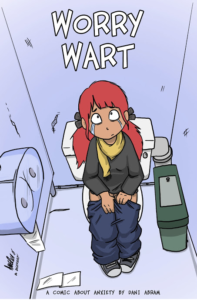
Worry Wart (2014), a comic by Dani Abram, gutsily captures the effects of an anxiety disorder that eventually reduced Abrams’ life to a mouse hole of fear, avoidance, and isolation. Abrams’ frank depictions of her gastrointestinal upsets, and brief amour with pills, combine to make a tonic for anyone’s who’s been there. Particularly powerful is her realization that loneliness spurred her anxiety. In her comic, she details the steps she took to reach out to others, which “was nothing short of miraculous.”

Anxiety Comics (2015-) by Stacy Bru, is a zippy, funny, and deeply felt series about the author’s experiences with a pervasive anxiety disorder. It captures the negative thinking spirals of anxiety pitch perfectly, toeing the line between hilarious and poignant.
I’m Really Scared: On Social Anxiety (2010-11), by Sylvia, a compact and gutsy zine, offers a genealogy of anxiety, tracing her own back to summer camp, where she sweats as the other girls “laugh and talk about boys and clothes.” Typewritten and handwritten overtop cut-and-paste images of pills, a daisy-chain of drugs: Ativan, Xanax, Klonopin, this zine is lionhearted.
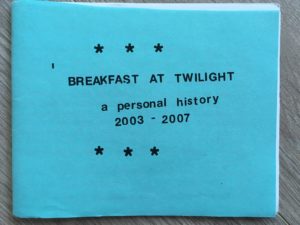 Breakfast at Twilight: A Personal History (2003-07), a fierce, smart perzine by Erica S., digs deep into the author’s experience of severe obsessive-compulsive disorder (OCD). It also smartly tackles the often-overlooked connection between financial precarity and mental health. When Erica was under-stimulated and precariously employed, her condition worsened; when she secured a job she enjoyed, she became healthier.
Breakfast at Twilight: A Personal History (2003-07), a fierce, smart perzine by Erica S., digs deep into the author’s experience of severe obsessive-compulsive disorder (OCD). It also smartly tackles the often-overlooked connection between financial precarity and mental health. When Erica was under-stimulated and precariously employed, her condition worsened; when she secured a job she enjoyed, she became healthier.
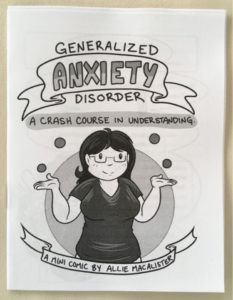
Generalized Anxiety Disorder: A Crash Course for Understanding (2016-), by Allie MacAlister, is a knowledge packed comic with terrific illustrations that details the author’s struggles with anxiety. A resource list is also included.
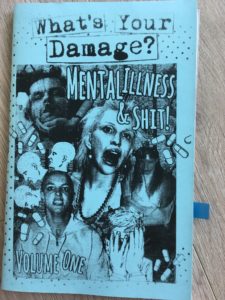
Work also organizes What’s Your Damage (2014), a zine of quotations collected by editor Deirdre Prudence while working in a psychiatric ward. Many pieces have a biting, quirky sense of humour that is complemented by the zine’s original and awesome design of acetate pages, vintage library card envelopes, buttons, and compelling images (a prescription bottle held aloft by cartoon angels, photocopies of Lithium packages).
Eating Disorders
Eating disorders affect 20% of women. They are the leading cause of death for women among mental illnesses. Yet their outward manifestations are socially tied to ideal femininity and celebrated by popular culture. Diary Entries from my Eating Disorders (2013), by Sofie Mikhaylova, explores these dichotomies. Central to this zine is the routinization, fear and shame that come with an eating disorder and eventually become a stand-in for identity. In plainspoken, piercing prose, Mikhaylova catalogues the obsessive eating rituals simmering beneath the mask of a happy life (like going online to read the Montana’s menu before dinner, to find the lowest calorie item) on her quest for “xylophone ribs.”
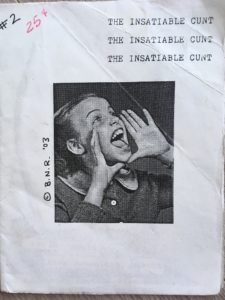
The Insatiable Cunt (2003), by B.N.R., meditates on the inner voices that fuel an eating disorder, imperatives like “it is better to be thin than to be healthy.” Like Mikhaylova, B.N.R writes about the deranged roller coaster that is anorexia and how, despite its promise to deliver happiness, it never lets the rider off even after they reach their “goal.” “I never saw a way out,” B.N.R. writes poignantly, capturing the claustrophobia and false stability of an ED.
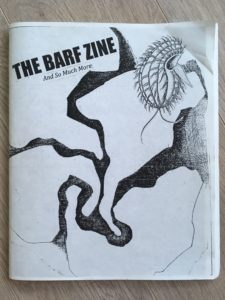
The Barf Zine (2013) is a gutsy collection of stories about eating disorders, food, the body, and recovery. Innovatively, all contributors structured their essays around the same list of questions, giving the zine a tidy cohesion.
Crazy/Not Crazy (2017) by Marin, details the author’s struggles with PTSD and body image issues, particularly weight gain. Detailed and raw, this zine grippingly shows the inter-connectedness of trauma and EDs while shining a light on recovery.
307.1 (undated), by Valley Simone, is premised on the idea that “eating disorders are wildly misunderstood.” Aiming to de-romantize and debunk glamorous myths about EDs, Simone deliberately wrote their trenchant zine only after their recovery for fear of “romanticizing my disorder as many suffer of an addiction unconsciously do.”
All comics and zines mentioned in this article are available at The Toronto Zine Library (torontozinelibrary.com), and/or on Etsy.com or their authors’ personal websites. The largest collection of zines by women-identified creators is at Duke University’s Sallie Bingham Center for Women’s History and Culture.
Thinking of Telling Your Own Story?
Artist and art therapist Quinn Riverburgh suggests creating a ritual around art-making that includes “opening” and “closing” rituals. Lighting a candle before you start drawing, and blowing it out when you’re done, may be helpful. By also practicing self-care (treating a writing/drawing day like you would a physical workout, making sure to have snacks and rest), one further creates a routine that is conducive to creativity.
